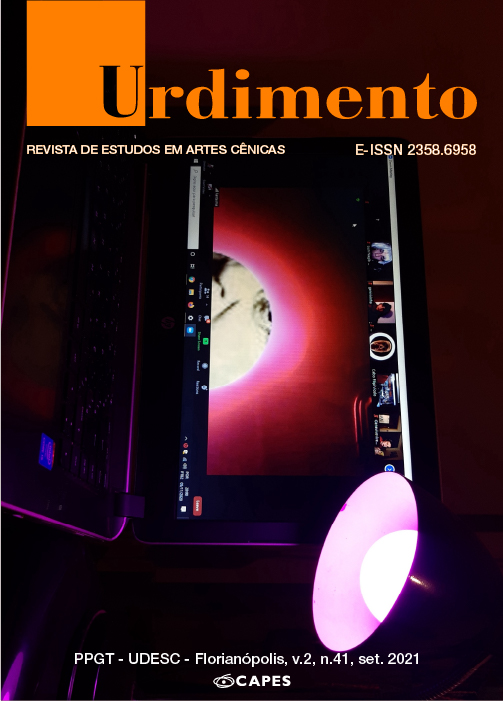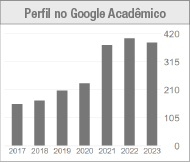Relational Art as Arts of Care for, with and by animals e Petformances
DOI:
https://doi.org/10.5965/1414573102412021e0125Keywords:
Petformance, Relational art, Animals, NatureAbstract
The paper proposes to cultivate the charms and the forces of life through the creation of performances with, for and by animals, called “petformances”, artistic language of the performance field, which I started to develop during the pandemic in partnership with my dog Buda. Cartographically describes the process that led to the experimentation of this type of relational performance in times of social distance, focusing on the deep learning brought by animals and the possibilities of multiplying these practices, through courses and workshops, in a perspective that decentralizes the vision of the human and values the creativity of animals.Downloads
References
ALICE, Tania. Performance como revolução dos afetos. São Paulo: Annablume, 2016.
ALICE, Tania. Manual para performers e não-performers. Rio de Janeiro: Editora Multifoco, 2020.
ANDERSON, Karen. Por que os gatos são assim? São Paulo: Publifolha, 2001.
BISHOP, Claire. Participatory Art and the Politics Spectatorship. London: Verso, 2012.
BOURRIAUD, Nicolas. Estética relacional. Trad. de Denise Bottmann. São Paulo: Martins Fontes, 2009.
DESPRET, Vinciane. Que diraient les animaux, si... on leur posait les bonnes questions? Paris: La Découverte, 2011.
FEITOSA, Charles. O silêncio dos animais. In. LINS, Daniel; OLIVEIRA, Nilson; BARROS, Roberto (Orgs.). Nietzsche/Deleuze: Natureza/Cultura. São Paulo: Lumme Editor, 2011.
HOOKS, Bell. O amor como a prática da liberdade: bell hooks.
(Love as the practice of freedom). Trad. para uso didático de Wanderson Flor do Nascimento, do original: Outlaw Culture. Resisting Representations. Nova Iorque: Routledge, 2006, p. 243–250. Disponível em: https://medium.com/enugbarijo/o-amor-como-a-pr%C3%A1tica-da-liberdade-bell-hooks-bb424f878f8c].
JUNIOR, Moacir. Tentativas de capturar o sensível: a fotoperformance e as artes presenciais. Revista Concept. São Paulo, v. 7, n. 1, p. 92-101, jan./jun. 2018.
PASSOS, E.; KASTRUP, V.; ESCÓSSIA, L. (Orgs.). Pistas do método da cartografia: pesquisa intervenção e produção de subjetividade. Porto Alegre: Sulina, 2014.
KESTER, Grant. Conversation pieces: community and communication. In: Modern art. Los Angeles: California Press, 2004.
KRENAK, Ailton. A vida não é útil. São Paulo: Cia das Letras, 2020.
KRENAK, Ailton. Ideias para adiar o fim do mundo. São Paulo: Cia das Letras, 2018.
MASSUMI, Brian. O que os animais nos ensinam sobre política. Trad. de Francisco Trento e Fernanda Mello. São Paulo: n-1 edições, 2017.
MBEMBE, Achille. Necropolítica. São Paulo: n-1 edições, 2018.
ROLNIK, Suely. Esferas da Insurreição: notas para uma vida não cafetinada. São Paulo: n.1 edições, 2019.
SERVIGNE, Pablo; CHAPELLE, Gauthier. L’entraide, une autre loi de la jungle. Paris: Les liens qui libèrent, 2017.
SIMAS, Luiz A.; RUFINO, Luiz. Encantamento: sobre política de vida. São Paulo: Morula, 2020.
TEIXEIRA, Renata. Performances do Encontro: práticas performativas em tempos de presença real e virtual. 2016. Dissertação (Mestrado em Artes Cênicas) - Universidade Federal do Rio Grande do Sul, 2016.
PISA, João Paulo; TACITO, Jorge; LEME, Denise. A arte como instrumento de ensino de bem-estar animal. Revista Pubvet, v. 13, n. 7, p. 1-7, 2019.
WERÁ, Kaká Werá. História indígena do Brasil contada por um índio. São Paulo: Peirópolis, 1998.
Referências filmográficas
The Animal Communicator: what if you could talk to animals. Direção de Swati Thiyagarajan & Craig Foster. Documentário. África do Sul: Natural History Unit Africa, 2012, 52 min.
Professor Polvo (My Octopus Teacher). Direção de Pippa Ehrlich & James Reed. Documentário – Ciência e Natureza. África do Sul: Netflix, 2020, 85 min.
Downloads
Published
How to Cite
Issue
Section
License
Copyright (c) 2021 Urdimento - Revista de Estudos em Artes Cênicas

This work is licensed under a Creative Commons Attribution 4.0 International License.
Copyright Statement
The articles published by the magazine are free to use. The copyright is all assigned to the magazine. The articles whose authors are identified represent the expression from the point of view of their authors and not the official position of the journal Urdimento. The author (s) undertakes whenever publishing material relating to the article published in Revista Urdimento mention the said publication as follows: This article was originally published by Urdimento magazine in its volume (put the volume), number (put the number) in the year of (put the year) and can be accessed at:
http://www.revistas.udesc.br/index.php/urdimento
This work is licensed under a Creative Commons Attribution 4.0 International License.




